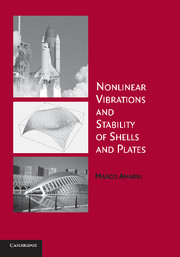Book contents
- Frontmatter
- Contents
- Preface
- Introduction
- 1 Nonlinear Theories of Elasticity of Plates and Shells
- 2 Nonlinear Theories of Doubly Curved Shells for Conventional and Advanced Materials
- 3 Introduction to Nonlinear Dynamics
- 4 Vibrations of Rectangular Plates
- 5 Vibrations of Empty and Fluid-Filled Circular Cylindrical Shells
- 6 Reduced-Order Models: Proper Orthogonal Decomposition and Nonlinear Normal Modes
- 7 Comparison of Different Shell Theories for Nonlinear Vibrations and Stability of Circular Cylindrical Shells
- 8 Effect of Boundary Conditions on Large-Amplitude Vibrations of Circular Cylindrical Shells
- 9 Vibrations of Circular Cylindrical Panels with Different Boundary Conditions
- 10 Nonlinear Vibrations and Stability of Doubly Curved Shallow-Shells: Isotropic and Laminated Materials
- 11 Meshless Discretizatization of Plates and Shells of Complex Shape by Using the R-Functions
- 12 Vibrations of Circular Plates and Rotating Disks
- 13 Nonlinear Stability of Circular Cylindrical Shells under Static and Dynamic Axial Loads
- 14 Nonlinear Stability and Vibration of Circular Shells Conveying Fluid
- 15 Nonlinear Supersonic Flutter of Circular Cylindrical Shells with Imperfections
- Index
- References
4 - Vibrations of Rectangular Plates
Published online by Cambridge University Press: 08 January 2010
- Frontmatter
- Contents
- Preface
- Introduction
- 1 Nonlinear Theories of Elasticity of Plates and Shells
- 2 Nonlinear Theories of Doubly Curved Shells for Conventional and Advanced Materials
- 3 Introduction to Nonlinear Dynamics
- 4 Vibrations of Rectangular Plates
- 5 Vibrations of Empty and Fluid-Filled Circular Cylindrical Shells
- 6 Reduced-Order Models: Proper Orthogonal Decomposition and Nonlinear Normal Modes
- 7 Comparison of Different Shell Theories for Nonlinear Vibrations and Stability of Circular Cylindrical Shells
- 8 Effect of Boundary Conditions on Large-Amplitude Vibrations of Circular Cylindrical Shells
- 9 Vibrations of Circular Cylindrical Panels with Different Boundary Conditions
- 10 Nonlinear Vibrations and Stability of Doubly Curved Shallow-Shells: Isotropic and Laminated Materials
- 11 Meshless Discretizatization of Plates and Shells of Complex Shape by Using the R-Functions
- 12 Vibrations of Circular Plates and Rotating Disks
- 13 Nonlinear Stability of Circular Cylindrical Shells under Static and Dynamic Axial Loads
- 14 Nonlinear Stability and Vibration of Circular Shells Conveying Fluid
- 15 Nonlinear Supersonic Flutter of Circular Cylindrical Shells with Imperfections
- Index
- References
Summary
Introduction
Flat rectangular plates with restrained normal displacement at the four edges exhibit a strong hardening-type nonlinearity for vibration amplitude of the order of the plate thickness. In order to have a behavior correctly described by a linear theory, the vibration amplitude of thin plates must be of the order of 1/10 of the thickness, or smaller. In-plane constraints largely enhance the nonlinear behavior; consequently, in-plane stretching is produced for large-amplitude deflection, differently from what is stated for linear theory.
Rectangular plates with normal displacement that is not restrained at all the edges can present a linear behavior for larger vibration amplitude. This is the case of the cantilever plate (clamped at one edge and free on the other three edges). In fact, quite large displacement w can be associated with very small rotations ∂w/∂x and ∂w/∂y for these boundary conditions, so that nonlinear terms in the strains can be neglected.
Geometric imperfections play an important role; they transform the flat plate in a curved panel (even if very shallow), which exhibits an initial weak softening behavior, turning to strong hardening nonlinearity for larger vibration amplitude.
In this chapter, the linear vibrations of simply supported rectangular plates are first addressed; numerical and experimental results are presented. Then, nonlinear forced vibrations of plates with different boundary conditions are studied by using the Lagrange equations of motion and the von Kármán theory. The effect of geometric imperfections is investigated. Numerical and experimental results are presented and satisfactorily compared.
- Type
- Chapter
- Information
- Nonlinear Vibrations and Stability of Shells and Plates , pp. 120 - 140Publisher: Cambridge University PressPrint publication year: 2008
References
- 1
- Cited by

